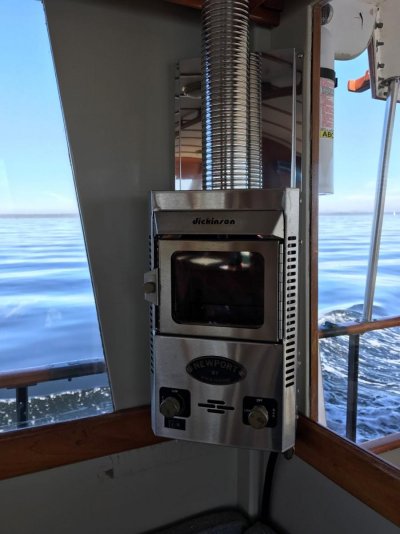I have put several diesel heating systems in boats the same size as your Camano. All the work done myself. Many of these boats did not have a generator, just like yours.
Here's what I found, the plusses and minuses.
Espar hydronic 
The Espar hydronic systems provided the ability to heat hot water without the main engine running. I installed a couple of heat exchangers on a single loop along with the potable water heater. A switch was added to just run the "boiler" without heating up tohe boat for hot water. Otherwise the system ran off off a thermostat in the cabin. Having two thermostats was easy to do as well so you could have a closed off sleeping cabin with its own temperature control.
These systems worked very well, and make a good choice for that sized boat. A challenge is that on any hydronic system there has to be a coolant "tank" at the highest point in the system. I found that a automotive coolant overflow tank works well for that purpose. This tank is where you will fill the system from so it needs to be accessable.
A really big challenge with any hydronic system is that you cannot remove the furnace for servicing, so you really need to have a spot to install it where you have room to comfortably work on it. On many boats this meant taking over a closet to put the furnace in. This also created a noise issue, but thats the nature of those types of furnaces as thay are a type that makes a significant amount of noise.
As a FYI I have not worked with the Webasto units, but they work exactly the same as the Espar, with all the same pros and cons.
Wallas diesel stove 
The Wallas Diesel stove replaced the OEM alchohol stove, which I did not like so it was an easy choice. This is a really easy installation as it dropped right in. I found that this was a great heater and stove. The concept was simple. If you leave the stove on, and shut the lid a blower turns on pushing air across the face of the sealed stove and warming the cabin. A knob regulated the amount of heat. Simple and effective. A challenge was that blowers make noise, but not so much as to affect conversation, or sleeping.
Wallas and Toyotomi forced air 
The Toyotomi heater was a good unit. I was a dealer for them back in the day when I sold marine heating systems. (Something I no longer do) The Toyotomi is manufacturer discontinued. The wallas is a similar design and in my opinion a really good furnace. I have these on my current boat.
Installing a forced air furnace is easy. A great place for these is underneath a dinette seat. There is generally a storage space that can be used. Since you can take the thing out in just a few minutes you do not need full access to work on them. They are extremely quiet, and use very lttle of your limited house battery capacity.
Conclusions 
I sold and serviced marine heaters for many years as part of my business. I no longer do that so I have zero to gain, only my hard earned experience to share.
I liked the hydronic unts only because of the hot water heating. On a boat in your size range heating water while on the hook is challenging, and this is where a hydronic unit shines. Other than that hydronic units are not my choice. They are noisey just due to the nature of how the burner operates, which is a stream of diesel being blown into a fast moving air stream. The sound is similar to a jet engine. In a bigger boat you can put the furnace in a place where the sound can be muffled, but on boat in the 30' size your choices are more limited.
If you take away the need to heat water the forced air units are my choice hands down. They are easier to install, they are much quieter, and they require less DC power to operate. One great advantage of the Wallas unts is that the exhause tube is enclosed in another tube dramatically reducing the temperature of the exhaust tube. This is a serious advantage from an installation standpoint. They are quieter because of the way the burner operates. These have a tube that drips diesel into a burner chamber that is bowel shaped. Air is pushed throgh the chamber but the velocity is low, and almost silent.
Best of luck on your choice


